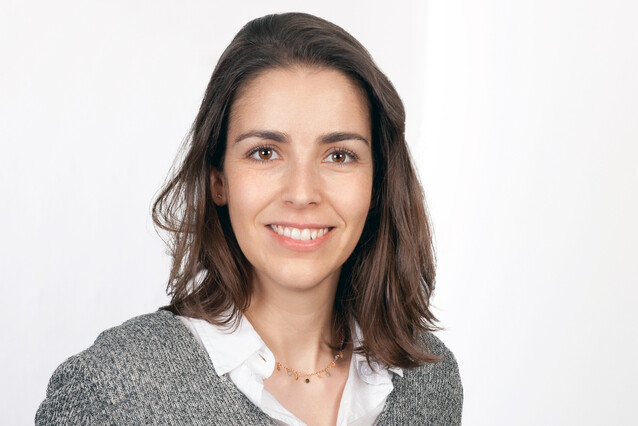Diana Pinheiro to establish research group at IMP
The cell and developmental biologist Diana Pinheiro, currently a postdoctoral researcher at the Institute of Science and Technology Austria in Klosterneuburg, will join the IMP as a group leader in autumn of 2022. The Pinheiro Lab will study the biophysical mechanisms underlying the emergence of embryonic pattern and shape, using both zebrafish embryos and self-organised human stem cell colonies as model systems.
Researchers who study the development of complex, multi-cellular organisms from a single cell have historically taken different routes. Traditionally, they either study how undifferentiated cells adopt the specific features of a certain cell type - this is often determined by gradients of molecular signals called morphogens - or they examine the physical forces acting to shape tissues into organs.
Through her postdoctoral research on zebrafish embryos, Diana Pinheiro recently showed that a gradient of highly conserved diffusible molecules (Nodal morphogens) determines not only the precise spatial patterns of cellular fates, but also a broad repertoire of mechanical properties. This “double-encoding” is key for coordinating large-scale embryo morphogenesis with patterning during gastrulation. Pinheiro will establish her own lab at the IMP in autumn this year and aims to explore the feedback between morphogen gradients and tissue mechanics, in particular whether and how they underly robust self-organisation.
“These are classic questions of my field: How are cell types established? How are these cells then arranged into tissues?” says Pinheiro. “We have learnt a lot about both questions in the past decade. But we still don’t understand how these key biological processes are robustly coordinated in time and space. For a cell to fulfil its function, it doesn’t just need to differentiate, it also needs to be at the right place. My lab will explore how a relatively small set of highly conserved developmental signals is able to encode all this complex information – patterning and morphogenesis – to coordinate embryogenesis across scales. You can see this beautifully in cultured pluripotent cells, which can self-assemble into embryo- or organ-like structures when only a few key morphogens are present.”
As a student in Portugal, Diana Pinheiro set out working on the molecular regulation of cell division; for her PhD with Yohanns Bellaïche at the Institute Curie in Paris, she studied how epithelial cells can actively sense and respond to the physical forces generated by neighbouring cells, so that the dramatic cell shape changes associated with cell division do not compromise the tissue barrier function. She then switched model system, from Drosophila pupae to zebrafish embryos, for her postdoctoral research in the lab of Carl-Philip Heisenberg at ISTA in Klosterneuburg near Vienna. By the end of the summer, she will trade the forest for the city and join more than 140 principal investigators at the Vienna BioCenter. It is the first time in decades that the IMP recruits a scientist as a group leader from within Austria – testimony for the strong growth of leading basic research institutions in this country. At the IMP, the Pinheiro lab will continue to work with zebrafish, but also expand to self-organised human embryonic stem cells.
“Zebrafish is a fantastic system, going from a single fertilised cell to a moving embryo with a beating heart in only 24 hours! And its ex utero development, size, and transparency make it wonderfully accessible for high-resolution live imaging” says Pinheiro. The molecular and biophysical tools necessary to dissect the complex feedbacks linking biochemical signalling, tissue patterning, and mechanical forces across scales have also become increasingly available in recent years. However, embryos also have their limitations, and this is where embryonic stem cell cultures will become a key actor in the Pinheiro lab: “Simplified 2D culture system have shown a remarkable self-organisation potential to form embryo-like structures. When it comes to altering features such as geometry, signalling cues or forces, they will be a great complementary model to compare and contrast with fish.”
When talking to Diana Pinheiro, one will soon note a special passion for microscopy – she recalls the beauty of spindles in dividing cells that mesmerised her as a student, and she is still a keen advocate of using a live imaging-based approach: “I see something – then I can believe it,” says Pinheiro half-jokingly. No wonder that she is especially looking forward to working with the bio-optics facility at the IMP.
Reflecting about her feelings towards the IMP, she shares excitement, and the impression that her first meeting with Vienna BioCenter PhD students left: “The students at the IMP seemed really mature and asked very insightful questions – both scientifically and from a mentoring perspective.” As a mentor and supervisor, she has a clear vision of what should guide the culture at her lab: cooperation, interdisciplinarity, and passion for the scientific questions at hand. “In research, progress is not always linear and, projects advance with some ups and downs. But if you find a project that you are passionate about, the urge to answer your overarching question will stay and this is what keeps you going and motivated.”
Pinheiro will have vacancies at all levels upon starting at the IMP. Scientists with an interest in Diana Pinheiro’s current work have a fresh opportunity for a closer look: she just uploaded a preprint outlining key findings from her postdoctoral work.
Further Reading
Diana Pinheiro, Roland Kardos, Édouard Hannezo, Carl-Philipp Heisenberg: “Morphogen gradient orchestrates pattern-preserving tissue morphogenesis via motility-driven (un)jamming”.
https://www.biorxiv.org/content/10.1101/2022.05.16.492018v1
